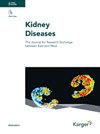Clinical and Histological Predictors of Renal Survival in Patients with Biopsy-Proven Diabetic Nephropathy
IF 3.2
4区 医学
Q1 UROLOGY & NEPHROLOGY
引用次数: 2
Abstract
Introduction: Clinical indicators or pathological features alone cannot reliably predict renal survival in patients with biopsy-confirmed diabetic nephropathy (DN). Therefore, this analysis sought to develop and validate a predictive model incorporating both clinical and pathological markers to predict renal outcomes in patients with biopsy-confirmed DN. Methods: A predictive nomogram was developed based upon data pertaining to 194 patients with biopsy-confirmed DN. The prognostic relevance of individual clinicopathological variables was assessed through univariate and multivariate Cox regression analyses. A prognostic nomogram was then developed and validated based upon concordance (C)-index values and calibration curves. Internal validation was conducted through bootstrap resampling, while the clinical utility of this model was assessed via a decision curve analysis (DCA) approach. Results: Nephrotic-range 24-h proteinuria, late-stage CKD, glomerular classification III–IV, and IFTA score 2–3 were all identified as independent predictors of poor renal outcomes in DN patients and were incorporated into our final nomogram. Calibration curves revealed good agreement between predicted and actual 3- and 5-year renal survival in DN patients with the C-index value for this nomogram at 0.845 (95% CI: 0.826–0.864). DCA revealed that our nomogram was superior to models based solely upon clinical indicators. Conclusion: A predictive nomogram incorporating clinical and pathological indicators was developed and validated for the prediction of renal survival outcomes in patients with biopsy-confirmed DN. This model will be of value to clinicians, as it can serve as an easy-to-use and reliable tool for physicians to guide patient management based on individualized risk.活检证实的糖尿病肾病患者肾生存的临床和组织学预测因素
临床指标或病理特征不能单独可靠地预测活检证实的糖尿病肾病(DN)患者的肾脏生存。因此,本分析旨在建立并验证一种结合临床和病理标志物的预测模型,以预测活检证实的DN患者的肾脏预后。方法:基于194例活检证实的DN患者的数据,开发了一种预测图。通过单因素和多因素Cox回归分析评估个体临床病理变量与预后的相关性。然后根据一致性(C)指数值和校准曲线开发和验证预后nomogram。通过自举重采样进行内部验证,而通过决策曲线分析(DCA)方法评估该模型的临床效用。结果:肾脏范围24小时蛋白尿、晚期CKD、肾小球分类III-IV和IFTA评分2-3都被确定为DN患者肾脏预后不良的独立预测因素,并被纳入我们的最终nomogram。校正曲线显示,预测的DN患者3年和5年肾脏生存与实际情况吻合良好,该nomogram C-index值为0.845 (95% CI: 0.826-0.864)。DCA显示我们的nomogram优于单纯基于临床指标的模型。结论:结合临床和病理指标的预测图被开发并验证用于预测活检证实的DN患者的肾脏生存结果。该模型对临床医生有价值,因为它可以作为一个易于使用和可靠的工具,为医生指导基于个体化风险的患者管理。
本文章由计算机程序翻译,如有差异,请以英文原文为准。
求助全文
约1分钟内获得全文
求助全文
来源期刊

Kidney Diseases
UROLOGY & NEPHROLOGY-
CiteScore
6.00
自引率
2.70%
发文量
33
审稿时长
27 weeks
期刊介绍:
''Kidney Diseases'' aims to provide a platform for Asian and Western research to further and support communication and exchange of knowledge. Review articles cover the most recent clinical and basic science relevant to the entire field of nephrological disorders, including glomerular diseases, acute and chronic kidney injury, tubulo-interstitial disease, hypertension and metabolism-related disorders, end-stage renal disease, and genetic kidney disease. Special articles are prepared by two authors, one from East and one from West, which compare genetics, epidemiology, diagnosis methods, and treatment options of a disease.
 求助内容:
求助内容: 应助结果提醒方式:
应助结果提醒方式:


